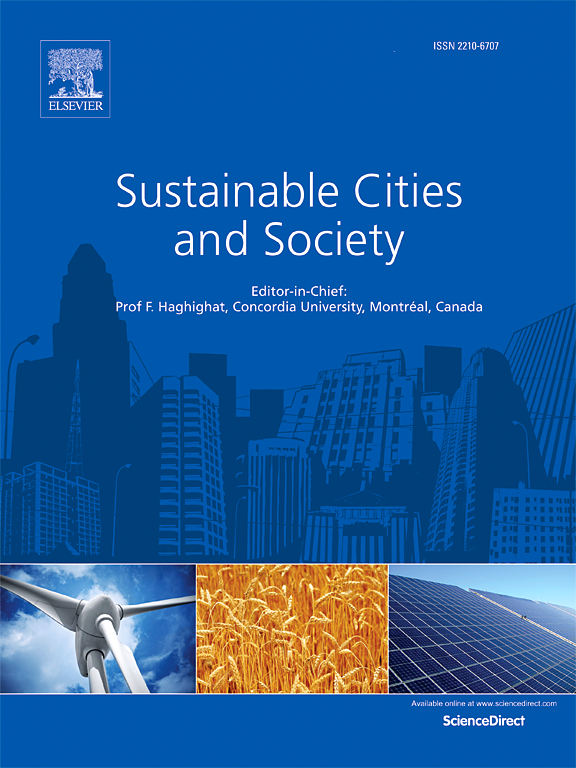Potential links between the progress in environmental governance and the prevalence of mental disorder burden: New insight from a dynamic panel-data analysis for 197 countries
IF 10.5
1区 工程技术
Q1 CONSTRUCTION & BUILDING TECHNOLOGY
引用次数: 0
Abstract
Background
Little is known about the extent to which addressing the serious challenges of environmental governance can alleviate the burden of mental disorders. This study aims to examine the potential association between the Environmental Performance Indicator (EPI) and the burden of mental disorders.
Methods
We measured the burden of mental disorders [loss of healthy life expectancy (HLE) due to mental disorders] and the EPI [Climate Change Mitigation (CCH), Air Quality (AIR), Sanitation and Drinking Water (H2O), and Heavy Metals (HMT)] for 197 countries from 1995 to 2019. The dynamic panel model was used to investigate the dynamic relationships between the EPI and the burden.
Results
For every 1-point increase in CCH, AIR, H2O, and HMT, the loss of HLE due to mental disorders decreased by 31.839 (95 % confidence interval: 7.777∼55.900), 281.229 (137.504∼424.953), -188.598 (-367.575∼-9.621), and 331.589 (136.714∼526.465) person-years per 100,000 people, respectively.
Conclusion
The advancement of sanitation and drinking water within the EPI does not appear to have had a favorable impact on reducing the burden of mental disorders. Efforts to reduce toxic by-products that may form during water treatment and include them in the assessment of the EPI may have potential benefits in reducing the burden of mental disorders.
环境治理的进展与精神疾病负担流行之间的潜在联系:对 197 个国家进行动态面板数据分析得出的新见解
背景人们对应对环境治理的严峻挑战能在多大程度上减轻精神障碍的负担知之甚少。本研究旨在探讨环境绩效指标(EPI)与精神障碍负担之间的潜在关联。方法我们测量了 1995 年至 2019 年期间 197 个国家的精神障碍负担[因精神障碍导致的健康预期寿命损失(HLE)]和环境绩效指标[减缓气候变化(CCH)、空气质量(AIR)、卫生和饮用水(H2O)以及重金属(HMT)]。结果 CCH、AIR、H2O 和 HMT 每增加 1 个百分点,精神障碍导致的 HLE 损失分别减少 31.839(95 % 置信区间:7.777∼55.900)、281.229(137.结论 EPI 中卫生和饮用水方面的进步似乎并未对减少精神疾病负担产生有利影响。努力减少水处理过程中可能产生的有毒副产品,并将其纳入 EPI 评估,可能会对减少精神疾病负担产生潜在的益处。
本文章由计算机程序翻译,如有差异,请以英文原文为准。
求助全文
约1分钟内获得全文
求助全文
来源期刊

Sustainable Cities and Society
Social Sciences-Geography, Planning and Development
CiteScore
22.00
自引率
13.70%
发文量
810
审稿时长
27 days
期刊介绍:
Sustainable Cities and Society (SCS) is an international journal that focuses on fundamental and applied research to promote environmentally sustainable and socially resilient cities. The journal welcomes cross-cutting, multi-disciplinary research in various areas, including:
1. Smart cities and resilient environments;
2. Alternative/clean energy sources, energy distribution, distributed energy generation, and energy demand reduction/management;
3. Monitoring and improving air quality in built environment and cities (e.g., healthy built environment and air quality management);
4. Energy efficient, low/zero carbon, and green buildings/communities;
5. Climate change mitigation and adaptation in urban environments;
6. Green infrastructure and BMPs;
7. Environmental Footprint accounting and management;
8. Urban agriculture and forestry;
9. ICT, smart grid and intelligent infrastructure;
10. Urban design/planning, regulations, legislation, certification, economics, and policy;
11. Social aspects, impacts and resiliency of cities;
12. Behavior monitoring, analysis and change within urban communities;
13. Health monitoring and improvement;
14. Nexus issues related to sustainable cities and societies;
15. Smart city governance;
16. Decision Support Systems for trade-off and uncertainty analysis for improved management of cities and society;
17. Big data, machine learning, and artificial intelligence applications and case studies;
18. Critical infrastructure protection, including security, privacy, forensics, and reliability issues of cyber-physical systems.
19. Water footprint reduction and urban water distribution, harvesting, treatment, reuse and management;
20. Waste reduction and recycling;
21. Wastewater collection, treatment and recycling;
22. Smart, clean and healthy transportation systems and infrastructure;
 求助内容:
求助内容: 应助结果提醒方式:
应助结果提醒方式:


